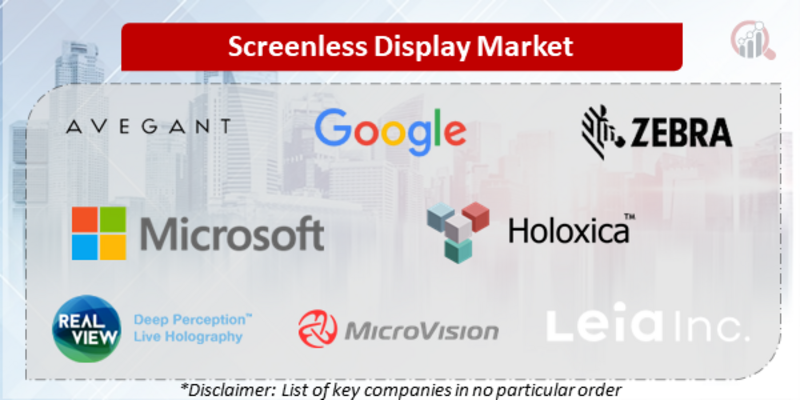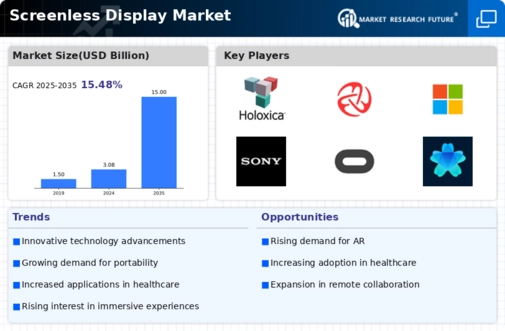Top Industry Leaders in the Screenless Display Market

Competitive Landscape of the Screenless Display Market
The screenless display market is a fascinating confluence of cutting-edge technology, immersive experiences, and fierce competition. Understanding the strategies employed by key players, the factors influencing market share, the influx of new entrants, and the overall competitive landscape is crucial for navigating this dynamic space. Rapid advancements in projection technologies, user interfaces, and material science constantly reshape the competitive landscape, demanding agility and adaptability from players.
Key Player:
- Avegant Corporation
- Google Inc.
- Displair Inc.
- Zebra Imaging Inc.
- Microsoft Corporation
- Holoxica Ltd.
- RealView Imaging Ltd.
- Leia Inc.
- Microvision Inc.
- Kapsys
Strategies Adopted by Market Leaders:
- Technology Diversification: Companies like Eon Reality and Sony invest in multiple screenless display technologies like holographic, retinal direct, and synaptic interface, catering to a broader range of applications.
- Partnership Play: Microsoft collaborates with automotive giants to integrate holographic displays into in-car dashboards, while Google teams up with entertainment studios for immersive theatrical experiences.
- Content Creation Focus: Realview Imaging Ltd. focuses on developing 3D content libraries specifically formatted for holographic displays, creating a competitive edge.
- Vertical Specialization: Alphabet Inc.'s Project Soli focuses on gesture-based screenless interaction, catering to healthcare and industrial applications.
- Early-Mover Advantage: Early entrants like Microsoft and Sony leverage their established brand reputations and existing customer base to gain a foothold in the market.
Factors for Market Share Analysis:
- Technology Leadership: Companies with proprietary screenless display technologies and advanced projection systems, like Sony's Spatial Reality Display, command premium pricing and secure market share.
- Content Ecosystem Development: Access to or creation of compelling 3D content for various applications like retail, advertising, and entertainment empowers companies to attract and retain customers.
- Regulatory Landscape: Navigating and adhering to complex regulations surrounding safety and health impacts of specific screenless display technologies like retinal interfaces holds strategic significance.
- Investment Potential: Companies with strong R&D capabilities and proven ability to attract venture capital or public funding are better positioned to fuel technological advancements and secure market share.
- Regional Focus: Asia-Pacific, with its strong tech adoption and focus on immersive experiences, leads in market size and growth potential, demanding regional customization strategies.
New and Emerging Companies:
The screenless display market is attracting a wave of innovative startups, bringing fresh perspectives and disruptive technologies. Companies like Looking Glass Factory, with its holographic light field displays, and Leia Inc., with its volumetric displays, are gaining traction. These startups, with their agility and focus on niche applications, pose a potential challenge to established players.
Universities and research institutions are also playing a crucial role in driving innovation. The University of Washington's Fovi Project, exploring gaze-contingent displays, and MIT's Media Lab, developing retinal displays, are examples of cutting-edge research with the potential to reshape the market.
Industry Developments:
December 2023,
- Microsoft Research is developing various screenless display technologies, including their "Illusion Hole" project that projects interactive content onto a physical table. They are also exploring the use of holographic displays for medical education and surgical training.
- Sony is developing "Spatial Reality Display" technology that projects images directly onto the retina, creating a personalized viewing experience without the need for glasses or bulky headsets. This technology has the potential to revolutionize entertainment, education, and even communication.
